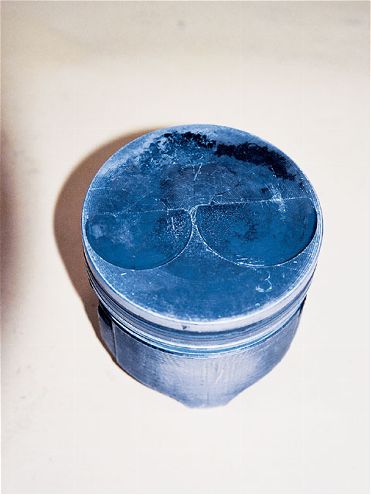Finding the Right TempQ: What's the normal operating temperature range of a Ford automatic transmission with overdrive? I don't have a stock application and don't run cooler lines to a heat exchanger in the radiator, because my vehicle is a modernized 1955 Willys Wagon with a modified 1986 Mustang 302 High-Output engine with electronic fuel injection. This powers a modified Ford transmission. It uses a large transmission cooler with a thermostatically controlled electric fan. The cooler is mounted under the frame near the rear axle because there's zero space up front due to the large radiator and air-conditioning condenser. At freeway speeds the temperature climbs to around 220-230 degrees, but cools to around 200 as soon as I slow down on an offramp. All the sources I've been in contact with only suggest "as cool as possible" or something close to the engine coolant temperature.
A: You're going to get a lot of different answers depending on whom you ask. Part of the reason is the variability among different model vehicles, transmissions, and driving conditions--plus, until recently, the rarity of factory-installed transmission temperature gauges on non-commercial applications. The service manual for a late-model Ford Super Duty pickup with an automatic transmission states normal operating transmission temperature to be 150 to 170 degrees F. Of course, these temperatures will amplify with speed and load due to the increase in friction. So the "cooler the better" theory seems to hold true in real-world applications. Aftermarket oil-cooler manufacturers use a graph depicting the decrease in transmission lifespan as average transmission-fluid temperatures increase. A significant drop in transmission longevity begins at temperatures above 175 degrees F, and a heat-induced chemical breakdown of the fluid at about 240. I wouldn't attempt to guess what the lowest temperature you can achieve on your tricked-out Willys might be, but reaching 230 on the highway without a cargo or trailer load appears to be on the high side. Perhaps the fan on the transmission cooler can be activated at a lower temperature by changing or adjusting the temperature switch. Or the fan may already be running full time to no avail due to the insufficient capacity of the cooling system. Mounting it to the frame at the rear axle isn't an ideal location for airflow.

| advice truck Drawing
Breaking the Trans CodeQ: The transmission in my 2004 Sport Trac 4x4 is beginning to shift hard and sometimes jumps when it finally shifts at around 3000 rpm. Eventually, the overdrive turns off automatically and the indicator light flashes, telling me the overdrive has been turned off. When I turn the engine off and restart it, overdrive's back on. I may not have any more problems for a day or so, but it's occurring about twice a week now.
A: This should be a straightforward job for a competent technician, but a handful for anyone else. The overdrive-off switch at the end of the shift lever has a simple function. If you don't touch it, the transmission shifts normally from first through fourth gear (overdrive). Once the switch is depressed, the O/D off indicator lights up on the instrument panel and the transmission only shifts from first through third gear. This eliminates O/D to enhance driveability while towing, taking a steep downgrade, or driving in poor traction conditions. The technical terms are "transmission control switch" and "transmission control indicator lamp," and both are linked to the powertrain control module. In your case, the indicator light is flashing, as opposed to continuously lit, which indicates a failure in the transmission's electronic pressure control circuit, or a monitored sensor. This particular fault appears to be intermittent. When the problem does occur, the PCM stores a trouble code in system memory, and then puts the transmission in a fixed "limp-home" mode. That's a default late hard shift pattern. Once the ignition is cycled (turned off and on again), the system goes back to normal operation until the failure repeats itself. It's going to require a system scan tool to read the transmission trouble codes and incoming data.
What's the Diff?Q: I just bought a Ford Explorer XLT 2002 4x2 with 93,000 miles, and there's a noise coming from the rear end at between 50 and 60 mph. I took the car to the shop and the technician told me the differential needs to be replaced. He also told me I could keep it for another three years without changing it, but it'll keep making the noise. If I replace the differential now, will this problem come back? I want to make sure replacing the differential will completely solve the problem.
A: Going by your account of the noise only occurring at highway speeds, I'll presume this is a whine or humming sound coming from the rear axle. That would indicate a problem with the main gears (ring and pinion). Typically, the tone of a gear whine will change significantly upon acceleration and deceleration because gear contact switches from one side of the gear teeth to the other. A more consistent growling or grinding noise would be symptoms of a worn-out differential or rear hub bearings. The 2002 Explorer incorporates a rear independent suspension, so the halfshafts or axles that connect the differential to the rear wheels are individual parts that flex with suspension travel, compared with a solid rear axle, which is all one piece. Replacing the ring-and-pinion gears themselves requires intricate adjustments such as pinion and carrier-bearing preload, backlash clearance, and confirming a good gear-tooth contact pattern. The surest way of eliminating the problem is by replacing the entire differential assembly with a brand-new unit from Ford, about $1000 for the part and four-hours' labor to install. If you're working with an independent shop, they may be suggesting replacement with a used or remanufactured rear-axle assembly. This could be a cheaper way out, but the potential for a repeat failure does increase. It's your call.

| advice mechanic
Nothing Cold up FrontQ: I have a 2003 seven-passenger TrailBlazer with a Vortec I-6 engine. My daughter drives the car, and she told me the air-conditioning fan didn't shut off right away when she turned off the engine. By the time I got around to checking it, the front panel fans/vents didn't blow any air at all. The rear vents work fine, but don't cool down the front of the truck. Do you have any ideas on what the problem can be, and any solutions short of pushing it off a cliff?
A: This problem has affected some of General Motors' pickups and SUVs equipped with automatic temperature-control HVAC systems. It's due to an internal breakdown within the blower motor control module, located beneath the right side of the instrument panel next to the blower motor. This electronic component varies voltage to control blower motor speed. For some reason, the failure causes the blower motor to stay on with the ignition off, just prior to a meltdown which eliminates power to the motor altogether. The blower motor for the rear of the TrailBlazer's passenger compartment isn't involved because it's part of an independent conventional circuit. The control module is more than likely the cause of your problem, but the failure should be confirmed by a technician. The part number for the updated blower motor control module is 93803636.
Domestic or ForeignQ: I plan to purchase a new 4x4 pickup in the next few months, but I'm faced with a dilemma, domestic or foreign? Judging by your readers' letters, almost all truck questions you answer are problems with domestic brands--or is it my imagination? Seldom do I see a question on a foreign-based vehicle with a problem. Does this mean there are more problems with domestic brands, or are you just picking out questions sent to you targeting these brands?
A: We never segregate readers' inquiries based on make, model, or the assembly plant of origin. We respond to the most interesting and understandable questions that contain sufficient information for us to provide an opinion on the best routes to take toward diagnosis and repair. The more detailed the questions, the better. It's great when readers include the vehicle identification number along with a clear description of the condition and previous action taken in attempting a fix. We do get questions a bit too broad to be practical, like "how do I overhaul the 390 in my 1972 Ford pickup?" We don't have enough editorial space to print that section of the service manual, so we're forced to move on to the next question. We do receive significantly more questions in reference to domestic as opposed to foreign-based trucks, the main reason being that the majority of trucks sold in the U.S are built by the Big Three. Although that may change as a result of Toyota's success and potential for expansion in the market, and by Nissan stepping up to the plate with its own fleet of full-size pickups and SUVs. Toyota builds some tough trucks. But Ford, GM, and DaimlerChrysler have made big strides over the past decade. With any luck, automakers will figure out that truck consumers are more interested in a bulletproof transmission than cash back or a DVD player.

| advice domestic Foreign
Durango DiagnosisQ: I have a 2000 Dodge Durango, and the engine light is always on. I had a local shop look at this while they were changing the exhaust system. The shop diagnosed the system and said the power-steering pressure switch was my problem. As I arrived home that night, I looked at my engine and noticed that the power-steering fluid container was messy, maybe a combination of dust and power-steering fluid. First, what does a power-steering pressure switch do? And is the mess on the power-steering container caused by the defective pressure switch? I saw from the internet that the P/S pressure switch costs only $19. If I have the switch, can you please tell me where and how to replace it myself? Please note that the dealer said it'll have to do another diagnostic test, which costs $98 plus the cost of the part and labor.
A: Only Durangos with the 4.7-liter V-8 incorporate a power-steering pressure switch, not the 5.2 or the 5.9. Trouble-code P0551 stored in the PCM's memory indicates a fault in the power-steering pressure switch circuit. In this case, the switch itself may be considered a weak link and odds point to that being the most likely cause of the check-engine light. But assumptions can often lead to the replacement of good parts. That's why the Dodge service department charges a diagnostic fee to confirm the failure by properly testing all applicable circuits. This eliminates shorted, grounded, or broken wiring, loose connections, and even the PCM as the root of the malfunction prior to condemning the switch. The power-steering pressure switch is located in the high-pressure line between the pump and the steering rack (close to the pump at the left/front of the engine). A dirty wet residue on the fluid reservoir may be the result of fluid condensation or spillage. Fluid dripping from the reservoir or the pump would be considered a significant leak that warrants repair. The switch's function is to signal the PCM when the power-steering system exceeds its normal operating hydraulic pressure, like when you cut the steering wheel all the way to one side and hear that hissing sound from the pump. The PCM then raises the idle speed and/or disengages the air-conditioning compressor to prevent the engine from stalling. A failure is noted and the trouble code set when the switch indicates a high-pressure steering condition above 40 mph. That shouldn't happen, so on goes the check-engine light. The pressure switch is inexpensive and easy to replace with the proper tools, but still a gamble without first confirming it to be at fault.
Shifty BusinessQ: I have a 2002 4x4 Ranger with an automatic transmission and the 4.0-liter V-6. Since I've owned the truck (which I bought used with 45,000 miles) it's had shifting problems. At first, there was a lag from shifting into gear and it actually engaging. Since then, I've had to replace the transmission, but I now notice a severe jolt putting the truck into gear. This is worse going from Drive to Neutral and then Reverse. My idle speed is 1100 rpm, which seems high, and I've been told this could be causing the issue. I'm concerned this may damage the differential, U-joints, etc. I was told to look at replacing the IAC (idle air control solenoid), which would correct all my woes.
A: It may be a hydraulic pressure or hard-part related condition within the transmission, but check into the elevated idle speed first. Normal idle speed on the Ford 4.0-liter should be 800 to 1000 rpm with the engine hot and the air-conditioning off. Anything above that can cause a harsh Drive or Reverse engagement. Don't condemn the IAC valve right off the bat. Ford has issued a technical service bulletin (number 03-3-5) because of unnecessary replacement of IAC valves in attempts to correct rough, low, and high idle conditions. There were no problems with approximately 95 percent of the valves replaced under warranty. Ford now requires a service advisor information sheet be submitted with details on the driveability complaint, and has provided technicians with additional tips on accurate diagnosis. Vacuum leaks, exhaust-gas recirculation and evaporative emission controls are just a few of the areas capable of producing similar improper idle conditions. It's worth a trip to the Ford service department to get an accurate description of the problem. If idle speed is ruled out as a cause, there have been problems with a clunk noise from the rear-driveshaft slip yoke that may be related, and correctable with lubrication. Once all else in the driveline is confirmed to be in good condition, next up will be the transmission itself.
Waiting for the JudgeQ: I have a 1998 Dodge Dakota with approximately 52,000 miles. I purchased the truck in 2003 from a five-star dealership. Within 24 hours, I heard a noise in the engine, which was diagnosed as a broken manifold bolt, but the dealership wouldn't make the repair. The truck is now in the middle of a lawsuit and I've been advised not to drive it because of the leak in the manifold. In the winter I cover the truck, and the way it's covered I can't move or start it. In the spring, summer, and most of the fall the truck is uncovered and moved and started three to four times a week. I did change the oil when I first purchased the truck. It's possible the truck could be ordered to be repaired or returned. What maintenance should be performed on the truck if the ruling comes back that it should be repaired? Can there be other problems that may result from the truck sitting for three years or longer?
A: Let me guess, your Dakota's equipped with the 2.5-liter four-cylinder engine and one or both of the outer exhaust-manifolds studs broke off, causing an exhaust leak. This condition involved some 2.5-liter vehicles built before December 1998. The fix is to remove the exhaust manifold, extract or drill out the broken studs, replace the gasket and hardware, and torque the outer studs to 180 inch-pounds, a few hours' labor and limited expense in parts. We find it difficult to fathom parking a 1998 Dakota for three years due to a lawsuit over a few hundred dollars in repairs. We recommend you fix the leak, save the broken studs for court proceedings, and be on your way. Like any other vehicle, if it's stored for more than several months without running, you should inject a lubricant into the cylinders to prevent cylinder-wall scoring from corrosive buildup. You should change the oil once a year even if it travels only a few miles. And after several years, change all the fluids and have the entire vehicle checked over by a technician. The depreciation while sitting there has already surpassed the cost of the broken studs.
How To Reach AlexIf you have a technical question regarding your pickup, SUV, or van, feel free to contact Alex, a master technician with the National Institute for Automotive Service Excellence. Send a letter to him in care of Truck Trend Garage, 831 S. Douglas Street, El Segundo, CA 90245, or e-mail us at trucktrend@sourceinterlink.com. Please include the VIN with your question. Due to the volume of questions received every month, we cannot guarantee that everyone's question will be personally answered or will appear in the magazine.
Can't wait for help with a problem you're having with your Truck or SUV? Ask the expert we trust here at Truck Trend Garage--visit Alex Steele at www.RealWorldAutomotive.com.
 | advice truck Drawing
Breaking the Trans Code
| advice truck Drawing
Breaking the Trans Code | advice mechanic
Nothing Cold up Front
| advice mechanic
Nothing Cold up Front | advice domestic Foreign
Durango Diagnosis
| advice domestic Foreign
Durango Diagnosis